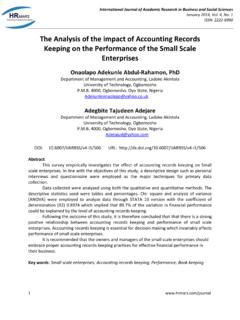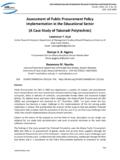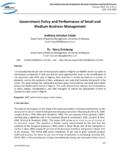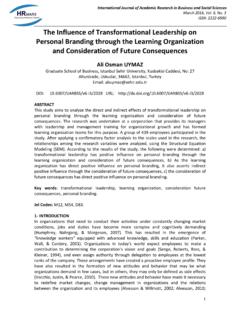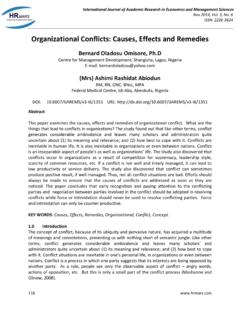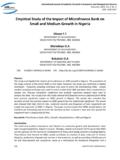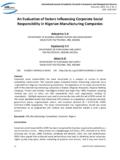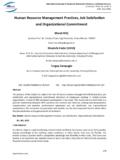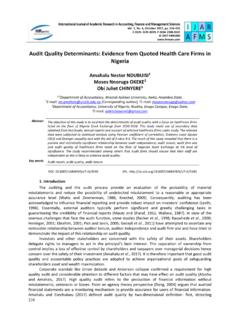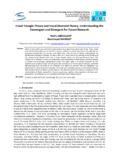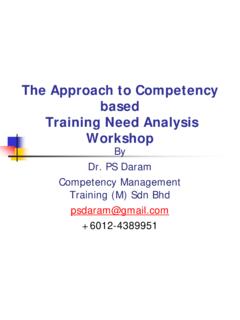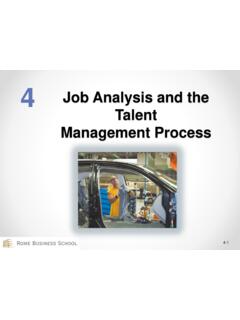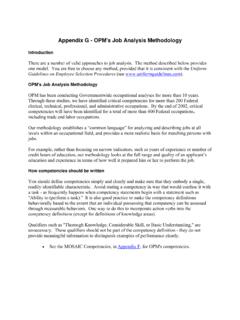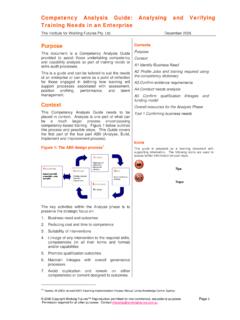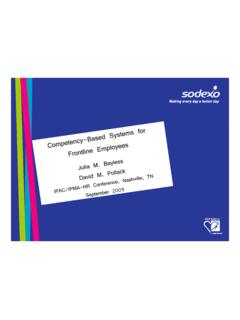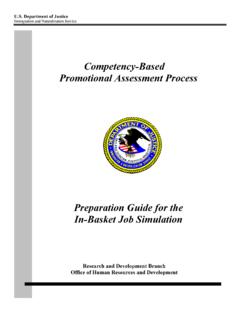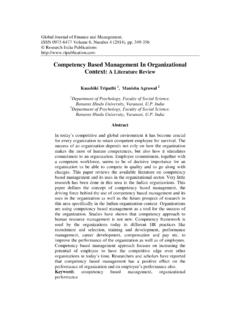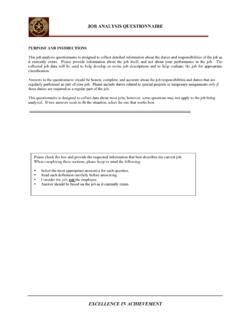Transcription of Competency based Job Analysis - hrmars.com
1 International Journal of Academic Research in Accounting, Finance and Management Sciences Vol. 3, , January 2013, pp. 105 111 ISSN: 2225-8329 2013 HRMARS Competency based Job Analysis Naveed SAIF1 Muh Saqib KHAN2 Khalid REHMAN3 Shafiq ur REHMAN4 Zia-Ur-REHMAN5 Tufail NAWA6 Muh NAQEEB7 1,2,3,6 Department of Business Administration, Gomal University, Dera Ismail Khan, Pakistan 1 Email; 2 Email; 3 Email; 6 Email; 4 University of Malakand (UOM), Pakistan, 4 Email; 5 Qurtaba, University Dera Ismail Khan Campus ,Pakistan , 5 Email: 7 Agriculture University Peshawar, PKP, Pakistan Abstract The study was conducted in March 2010 at Bank of Khyber Main Head office, Peshawar with an object to assess Competency based job performance.
2 A stratified random sample of 60 employees from a total of 200 employees was taken for this study. Out of which 9 respondents were from top level, 36 from middle level and 15 respondents were from lower level of management. Competency of the respondents was judged in term of knowledge, skill and attitude using Likert scale. Further, a chi-square test was used to assess the association between Competency (knowledge, skill, and attitude), job Analysis and performance. The estimated results showed that performance and job satisfaction were strongly associated. Similarly knowledge (shared and priorities) and skill (training and willingness) were strongly associated with job performance.
3 However, attitude (tolerated and productive) of the respondent were insignificantly associated with job performance. Finally, it is recommended that organization may focus on knowledge, skill and particularly on attitude by arranging training to improve performance level of the respondents. Key words Competency , job performance, knowledge, performance, training 1. Introduction Competency is the combination of knowledge, skills, abilities, values and interest. The use of the term Competency as applied to the world of work is most commonly thought to have been first used by David McClelland, a psychologist in the early 70s.
4 At that time, he argued that conventional tests of intelligence and abilities did not predict job performance or success in life and that they were biased against different groups. He invited the term competencies to overcome these defects, suggesting that they made possible the development of valid and unbiased predictors of performance. His approach included interviewing superior performers, identifying what they did differently from average performers and using the competencies identified for selection purposes. Competencies included motivation such as achievement, orientation, traits and specialized knowledge or skills McClelland Company, McBer eventually became part of a large human resource consulting firm.
5 A number of prominent speakers on the subject of competencies, including Lyle Spencer and Richard Boyzatis, have their roast in the Mcbers work. Knowledge is defined variously as expertise, and skills acquired by a person through experience and education. The theoretical or practical understanding of a subject, what is know in a particular field or in International Journal of Academic Research in Accounting, Finance and Management Sciences Vol. 3 (1), pp. 105 111, 2013 HRMARS 106 total, facts and information or awareness or familiarity gained by experience of fact or situation. Philosophical debates in general start with Plato's formulation of knowledge as justified true belief.
6 7'here is however no single agreed definition of knowledge presently or any prospect of one and there remain numerous competing theories. Skills are the practice of understanding, developing and deploying people and the skills. Well implemented skills management should identify the skills that jobs roles require, the skills of individual employees, and any gap between the two. The skills involved can be defined by the organization concerned, or by third party institution. They are usually defined in terms of a skills framework, also known as a Competency framework or skills matrix.
7 This consists of a list of skills, and a grading system, with a definition of what it means to be a particular level for a given skill. To be most useful, skills management need to be conducted as an ongoing process, with individual. Job Analysis Job Analysis is the basic and important part of human resource management (HRM). It covers the job Analysis activity under the sub process of human resource planning. Job Analysis is conducted after work-force Analysis and availability Analysis , (Hellriegel and Slocum Jr. 1993). It also indicates what activities and accountabilities the job entails.
8 It is an accurate recording of the activities involved. Every job is multifaceted and there are several methods in preparing job Analysis . Most organizations prepare job Analysis , statements of performance and expectations of employee at floor and at the managerial level. The content of these statements varies considerably from one company to another, depending in large part on the uses to which the information is put. People performing a job may be observed and questioned. Various training manuals and other job-related materials may be made available to job holders, supervisors, and others who are knowledgeable may be interviewed or asked to complete written questionnaires.
9 On occasion, photographs and films of the work, examination of tools and equipment, and actual performance of the job by a job analyst. Background of the study Job Analysis is a term used by human resource managers for the processes of collecting information related to job contents. Schuman and AhJburg (1994) compared tasks performed on the job with knowledge, skills and abilities of the jobholders. The information provides job description that becomes summary report of each job in the organization. Job descriptions are the basic inputs to job evaluation, which are used to assess the characteristics along with the working conditions of each job by assigning numerical points to the duties, responsibilities and efforts required for each job.
10 This numerical score (job points) measures the relative value of each job lo the organization (Sehuman et. al., 1994). A job Analysis provides an objective picture of the job, not the person performing the job, and as such, provides fundamental information to support all subsequent and related HR activities, such as recruitment, training, development, performance management and succession planning. Job Analysis serves two critical functions with respect to these processes. Job Analysis helps ensure that decisions made with respect to HR processes are good decisions, fair and accurate ( selection of the right person for the job, appropriate decisions about training, performance management, development, etc) and it helps ensure the defensibility of decisions made to employees (resulting in good HR management) and to the court (resulting in savings of costs, time and reputation).
